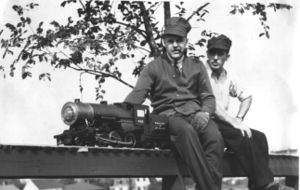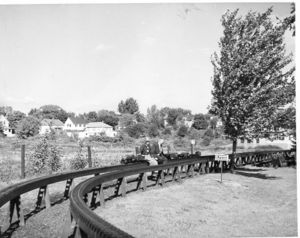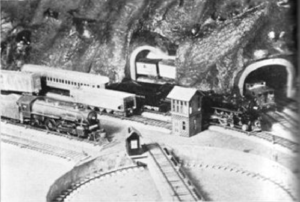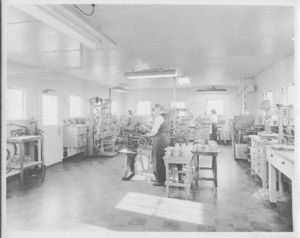Lester Friend
In July 1941, Lester Friend, President of the New England Live Steamers, paid a visit to Southern California, with the intent of getting the local live steamers to form a club. He met with Dick Bagley, Eddie Sargent, Kyle Testerman, Arthur "Bud" Stump, and C.S. "Stan" Chovil and in January 1942, The Southern California Live Steamers was formed with 35 charter members at Richard B. Jackson's backyard machine shop in Beverly Hills, CA. The membership elected Dick Bagley, chair; Dick Johnson, vice chair; Stan Chovil, treasurer; Bud Stump, secretary; and Ward Kimball, corresponding secretary.
History
By John Kurdzoniak, from Friends "Yankee Shop" Models:
The Friend Box Company was founded in 1884 by members of the Friend family, and did business at a factory in Danvers, Massachusetts (about 20 miles north of Boston, in Essex County), making rigid cardboard boxes such as jewelry boxes, cigar boxes, etc.
Lester Danforth Friend (also known as "L.D. Friend" and even just "L.D.F.") was born in 1895, and probably entered "the family business" as a teenager or as a young man. He served in World War I, and met Walt Disney sometime during the War. They were lifelong friends from that point on.
By the 1930s, it appears as if Friend Box Company was wholly-controlled by Lester Friend. Every story I've ever heard, from those who knew him, says that Lester Friend "owned" the box factory (but whether he was its President, or a major stockholder, or its "owner", is no longer known by any living members of the live steam hobby, as those who knew, are all deceased). Regardless of what position he held, Lester was "the boss" at the box company. (The Friend Box Company is still in business today, but is no longer owned by the Friend Family.
Classic Live Steam of Yesteryear
Our History: 1938-1972
The Friend Box Company was founded in 1884 by members of the Friend family, and did business at a factory in Danvers, Massachusetts (about 20 miles north of Boston, in Essex County), making rigid cardboard boxes such as jewelry boxes, cigar boxes, etc.
Lester Danforth Friend (also known as "L.D. Friend" and even just "L.D.F.") was born in 1895, and probably entered "the family business" as a teenager or as a young man. He served in World War I, and met Walt Disney sometime during the War. They were lifelong friends from that point on.
By the 1930s, it appears as if Friend Box Company was wholly-controlled by Lester Friend. Every story I've ever heard, from those who knew him, says that Lester Friend "owned" the box factory (but whether he was its President, or a major stockholder, or its "owner", is no longer known by any living members of the live steam hobby, as those who knew, are all deceased). Regardless of what position he held, Lester was "the boss" at the box company. (The Friend Box Company is still in business today, but is no longer owned by the Friend Family.
In 1938, Lester built the New England Live Steamers track on the property behind his box factory. It was a 2-1/2" and 3-1/2" gauge elevated ("highline") loop of track some 600' in length that went out to the bank of the Porter River, a tidal marsh, and then returned. On its return, it crossed a "high trestle" over part of the tidal marsh. This "High trestle" was about 8 feet off the ground.
Charlie Purinton, the son of Brotherhood of Live Steamers founder Charles A. "Carl" Purinton (1898-1999), has told me (John Kurdzoniak) that he and some local live steamers of the era (and several of Lester Friend's employees of the box company) helped to build the NELS Danvers track, and that it was built in less than a month! Charlie was 16 years old at the time.
O Gauge Layout
From "The Model Railroader", page 422, date unknown.
North Mountain RR.
Hardest Problem Tacked First, Building an O Gauge Live Steam Loco.
By L.D. Friend
My first trail in model railroading was, I believe, a tremendous jump, as I started in by building a 1/4-inch scale live steam pacific, using Birch castings. To the surprise of myself, as well as my friends, it ran with spool valves and all. In fact, it operated so well that I was able to load 50 odd pounds of dead weight iron behind it, sticking a flat-iron on top of the seam dome for added traction to keep the drive wheels from spinning. She would take off as nicely as the prototype.
After completing my live steamer, I found it very bothersome to start this up every time one of my friends wished to see the railroad run. So I decided to construct my road for dual operattion, both electric and steam.
Gondolas, hopper cars, box cars, reefers were the next attempt, of which I have now all told eight cards with a crummy. Not being satisfied with the conventional straight railroad which ran around on benches, I included in my plans mountains, grades, bridges and culverts, with the result that I now have completed three mountains, three tunnels, a cut through a ledge and about 220 ft. of completed track, rock ballasted, with electric switches and whatnot.
The roundhouse is partically completed. The turntable is finished with the exception of motorization. The control panel is a maze of buttons. The road requires a bit of ingenuity to operate, with its eight electric and five manually operated switches, automatic reverse and sectional cutouts.
All of this is in a room set aside in my basement with a total area of about 25 x 11 ft. and of course on benches that are 36 inches from the floor. The benches have all been made so that as I contrct my valleys, fields, etc., I may use regular sand and it will not fall through the benches to the floor.
I am now working up a system, nearly completed, for individual lighting, as I have found that a large ceiling bulb for lighting detracts value from the railroad. indirect lights with very small bulbs in and around the depots. Layered trees improve the perspective greatly.
I expect it will take another year to complete the scenic effects of the North Mountain RR., and then I expect to start on a 3/4-inch scale steamer whcih has always been my dream.




